
The Liverpool and Manchester Railway (L&MR) was the first inter-city railway in the world. It opened on 15 September 1830 between the Lancashire towns of Liverpool and Manchester in England. It was also the first railway to rely exclusively on locomotives driven by steam power, with no horse-drawn traffic permitted at any time; the first to be entirely double track throughout its length; the first to have a true signalling system; the first to be fully timetabled; and the first to carry mail.

Earlestown railway station is a railway station in Earlestown, Merseyside, England, and one of the few "triangular" stations in Britain.
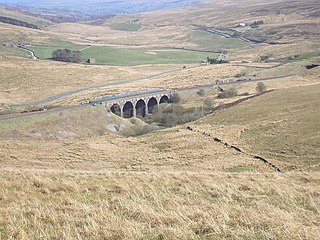
The Hawes Junction rail crash occurred at 5.49 am on 24 December 1910, just north of Lunds Viaduct between Hawes Junction and Aisgill on the Midland Railway's Settle and Carlisle main line in the North Riding of Yorkshire, England. It was caused when a busy signalman, Alfred Sutton, forgot about a pair of light engines waiting at his down (northbound) starting signal to return to their shed at Carlisle. They were still waiting there when the signalman set the road for the down Scotch express. When the signal cleared, the light engines set off in front of the express into the same block section. Since the light engines were travelling at low speed from a stand at Hawes Junction, and the following express was travelling at high speed, a collision was inevitable. The express caught the light engines just after Moorcock Tunnel near Aisgill summit in Mallerstang and was almost wholly derailed.

The St Helens and Runcorn Gap Railway was an early railway line owned by a company of the same name in Lancashire, England, which opened in 1833. It was later known as St Helens Railway. It ran originally from the town of St Helens to the area which would later develop into the town of Widnes. Branches were opened to Garston, Warrington and Rainford. The company was taken over by the London and North Western Railway in 1864. The line from St Helens to Widnes and the branch to Rainford are now closed, the latter terminating at the Pilkington Glass' Cowley Hill works siding near Gerard's Bridge, but part of the lines to Garston and to Warrington are still in operation.

The Runcorn Railway Bridge, Ethelfleda Bridge or Britannia Bridge crosses the River Mersey at Runcorn Gap between Runcorn and Widnes in Cheshire, England. It is alongside the Silver Jubilee Bridge. The bridge is recorded in the National Heritage List for England as a Grade II* Listed building.

Runcorn was a rural district in Cheshire, England from 1894 until 1974. It was named after but did not include Runcorn, a town on the River Mersey to the north-west of the district, which formed its own urban district.

Over the latter years of the 19th and early years of the 20th centuries, Penistone in Yorkshire gained a name as an accident black-spot on Britain's railway network; indeed, it could be said to hold the title of the worst accident black-spot in the country. The main line through the town was the Woodhead route of the Manchester, Sheffield and Lincolnshire Railway between Sheffield Victoria and Manchester, London Road. The line was heavily graded with a summit some 400 yards inside the eastern portal of the Woodhead tunnel.
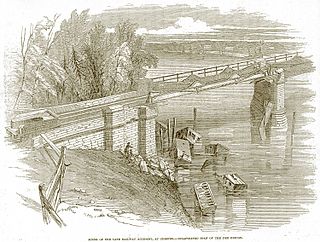
The Dee Bridge disaster was a rail accident that occurred on 24 May 1847 in Chester, England, that resulted in five fatalities. It revealed the weakness of cast iron beam bridges reinforced by wrought iron tie bars, and brought criticism of its designer, Robert Stephenson, the son of George Stephenson.

Frodsham railway station serves the town of Frodsham, Cheshire, England. The station is managed by Transport for Wales. It was opened along with the line in 1850 and the station building is recorded in the National Heritage List for England as a designated Grade II listed building. This was restored in 2012 and is in private ownership.

The Mid-Cheshire line is a railway line in the north-west of England that runs from Chester to Edgeley Junction, Stockport; it connects Chester with Manchester Piccadilly, via Knutsford. After Chester Northgate closed in 1969, the section between Mickle Trafford Junction and Chester was used for freight trains only until it closed in 1992; from Mickle Trafford, passenger trains use the Chester–Warrington line to Chester General instead. The route taken by passenger trains has changed over the years and now differs considerably from the original. Between 2001 and 2014, passenger journeys on the line increased to over 1.7 million per year. A near doubling of the passenger service was expected to occur from December 2018, however this did not materialise.

Kingsley is a civil parish and a village in the unitary authority of Cheshire West and Chester and the ceremonial county of Cheshire, England. It is approximately 5 miles south east of the town of Frodsham.

Halton Curve is a short bi-directional railway line which links the Chester–Warrington line to the Weaver Junction–Liverpool line within the borough of Halton, Cheshire. The route, which is 1 mile 54 chains (2.7 km) long, is between Frodsham Junction and Halton Junction. After having no regular services for more than four decades, the line was upgraded and reopened in 2019 by Network Rail, enabling hourly passenger trains between Chester and Liverpool.
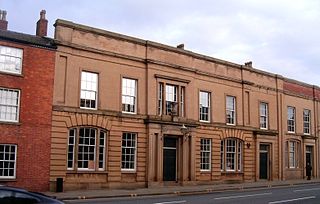
Liverpool Road is a former railway station on the Liverpool and Manchester Railway in Manchester, England; it opened on 15 September 1830. The station was the Manchester terminus of the world's first inter-city passenger railway in which all services were hauled by timetabled steam locomotives. It is the world's oldest surviving terminal railway station. With tracks running at a first floor level behind the building, it could also be considered one of the world's first elevated railway stations.

The Chester–Warrington line is a railway line running between Chester and Warrington Bank Quay in North West England.

Sutton Weaver is a village and civil parish in the unitary authority of Cheshire West and Chester, in the ceremonial county of Cheshire, England. It is 2 miles (3.2 km) northeast of Frodsham and 2.5 miles south of Runcorn. According to the United Kingdom Census 2011, it had a population of 495 and a total land area of 3,198 sq metres (m2) (thousands). The village has 206 Households with some of the main industries of the village being Wholesale and Retail Trade, Human Health and Social Work Activities and Manufacturing; These three sectors alone account for 36.5% of Occupational Share.
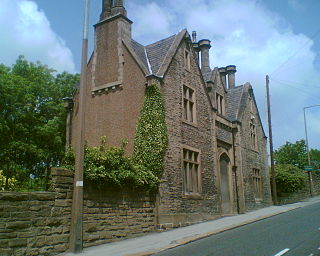
The Holmfirth branch line is a disused railway line that ran for 2 miles (3.2 km) from Brockholes to Holmfirth, in West Yorkshire, England. The line was built as double track as there were plans to extend the line up the Holme Valley.
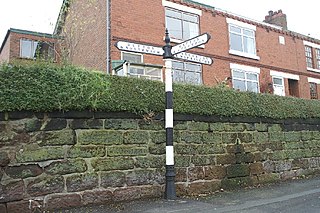
Preston on the Hill is a village and former civil parish, now in the parish of Preston Brook and the unitary authority area of Halton, in Cheshire, England. It is between the villages of Daresbury 1.5 miles (2.4 km) to the north and Dutton 1.1 miles (1.8 km) to the south. The village comprises the hamlets of Windmill Lane, Waterfront, Cotton's Bridge, Tunnel End North, Tunnel Top and Barker's Hollow as well as several farms including White House, Little Manor, New Manor, Windmill Farm and Humble Bee House.

The Birkenhead Railway was a railway company in North West England. It was incorporated as the Birkenhead, Lancashire and Cheshire Junction Railway (BL&CJR) in 1846 to build a line connecting the port of Birkenhead and the city of Chester with the manufacturing districts of Lancashire by making a junction near Warrington with the Grand Junction Railway. The BL&CJR took over the Chester and Birkenhead Railway in 1847, keeping its own name for the combined company until it shortened its name to the Birkenhead Railway in 1859. It was taken over jointly, on 1 January 1860, by the London and North Western Railway (LNWR) and the Great Western Railway (GWR). It remained a joint railway until nationalisation of the railways in 1948.
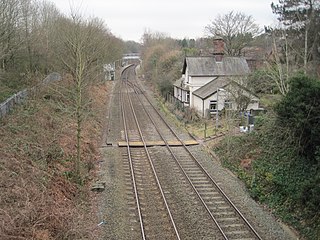
Norton railway station was a station near Norton, a village to the east of Runcorn, Cheshire, England. It was located just north of the 1.25 mile (2 km) Sutton Tunnel and was built as a result of the recommendations of a Board of Trade enquiry into a fatal accident in the tunnel the previous year.



















